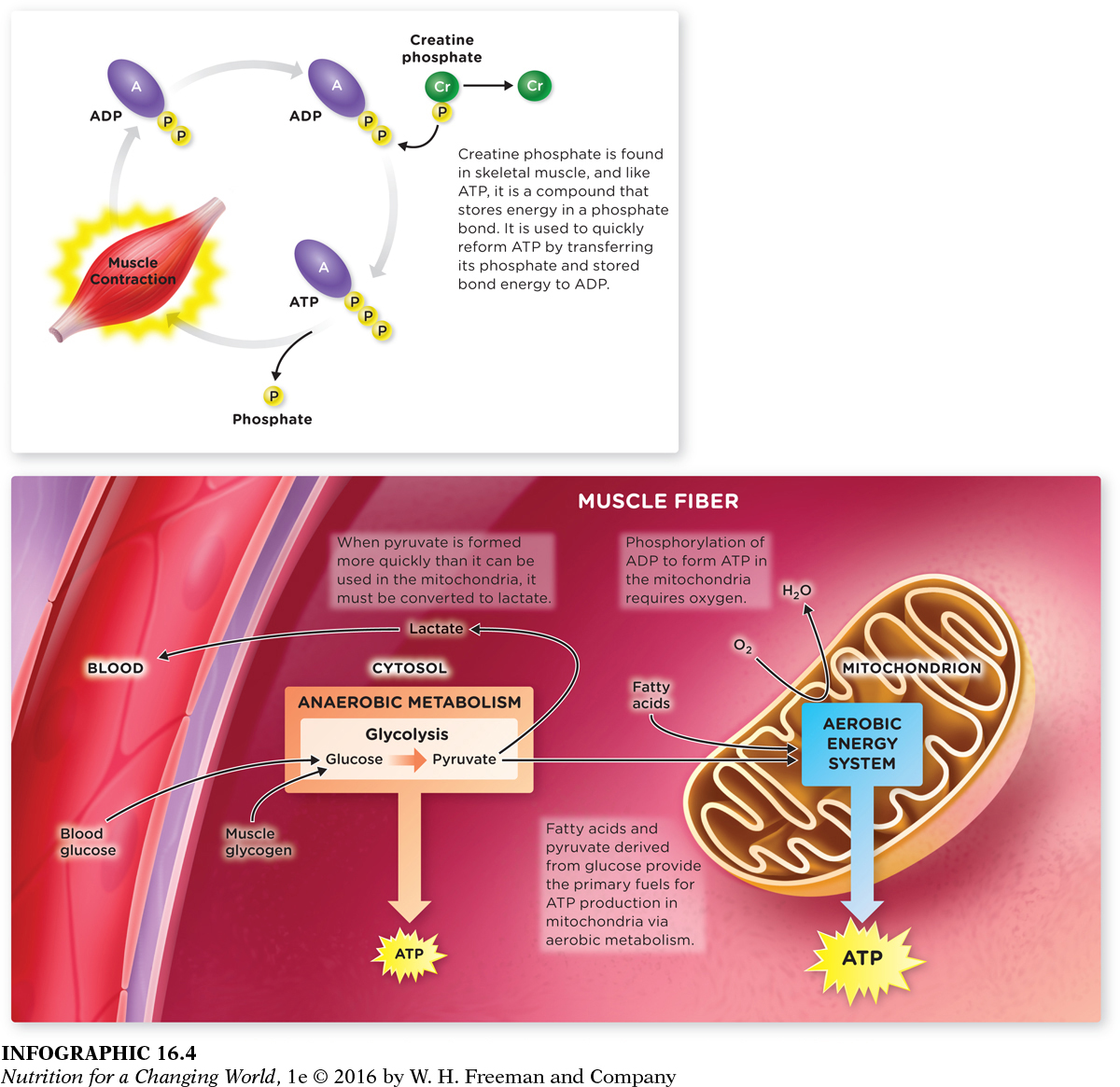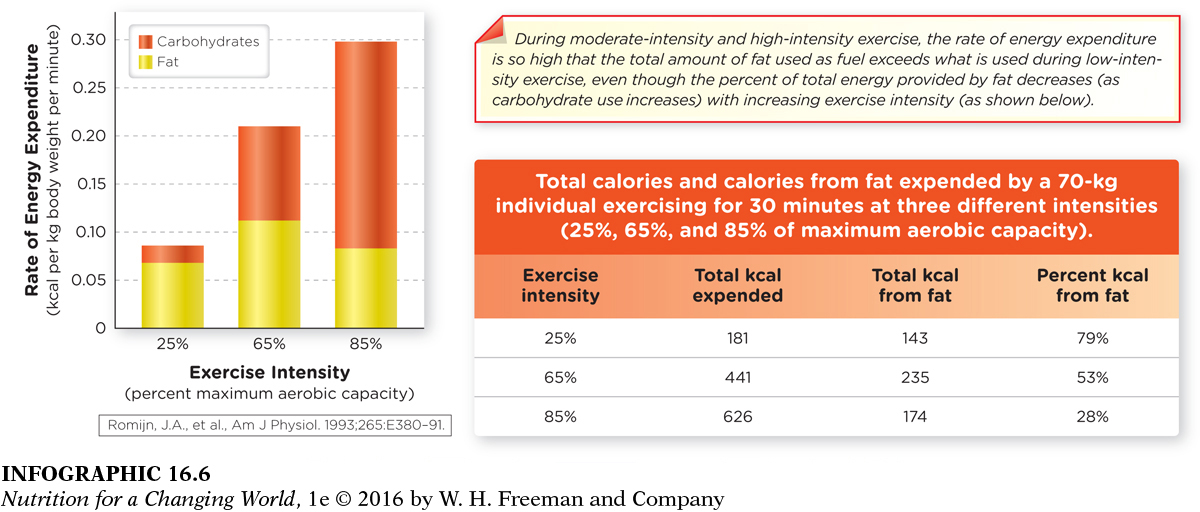FUELING THE BODY
ENERGY SUBSTRATES macronutrients used by the body to provide energy
When a person exercises, muscles experience an increased demand for energy to contract. That energy comes from one of two main sources: carbohydrates in the form of glucose and fats in the form of fatty acids. These energy substrates provide the fuel that humans need to keep moving.
ADENOSINE TRIPHOSPHATE (ATP) the primary energy currency of our cells
Both glucose and fatty acids are rich in chemical energy, stored in the chemical bonds holding the molecules together. Before that energy can be tapped by the body, however, it must be converted to a form that cells can use to perform work. That usable form is called adenosine triphosphate (ATP). Commonly referred to as the cell’s energy currency, ATP stores chemical energy in the bonds of its three phosphate groups. When our cells need energy, they typically break the bond between the last two phosphates, releasing the stored energy and forming adenosine diphosphate (ADP). (The “di” in diphosphate means “two,” as in two phosphates; the “tri” in “triphosphate” refers to its three phosphates.)
You can think of the energy in glucose and fat as the value of a gold brick: It’s worth a lot of money, but you couldn’t buy even a cup of coffee with it. ATP, however, is like bills and coins—
ANAEROBIC occurring in the absence of oxygen
AEROBIC occurring in the presence of oxygen
CYTOSOL fluid inside cells
MITOCHONDRIA an organelle in the cytoplasm of cells that functions in aerobic energy production
ATP is produced in the body by three separate energy systems, two of which are anaerobic (not requiring oxygen), and one of which is aerobic (requiring oxygen). The anaerobic energy systems reside in the cytosol, the intracellular fluid of the cell outside the mitochondria. The aerobic energy system resides in mitochondria, small organelles within cells that are often called the powerhouses of our cells because this is where the vast majority of all ATP is produced. The production of ATP in mitochondria is completely dependent on the availability and use of oxygen. These three energy systems differ in the speed at which they replenish ATP for use by cells and, in the case of the aerobic energy system, the fuel that is burned. (INFOGRAPHIC 16.3)

Question 16.1
 What fuel can provide ATP both anaerobically and aerobically? Why would someone run slower if they are relying on fat as the primary fuel?
What fuel can provide ATP both anaerobically and aerobically? Why would someone run slower if they are relying on fat as the primary fuel?
Glucose can provide ATP anaerobically and aerobically through the breakdown of glucose in glycolysis, and aerobically through the oxidation of glucose. A runner would run slower when relying on fat as the primary fuel because ATP is produced slowly through fat oxidation relative to the other energy systems.
Anaerobic energy systems
CREATINE PHOSPHATE (PHOSPHOCREATINE) a compound that readily transfers its phosphate and stored bond energy to ADP to replenish ATP
Why have three separate ways to make ATP? These systems provide overlapping coverage to replenish ATP over the short, medium, and long terms. The most important source of energy for short bursts of highly intense exercise, such as the 15-
370
GLYCOLYSIS a series of metabolic reactions in the breakdown of glucose to provide energy
PYRUVATE a compound produced from the breakdown of glucose; lactate is produced from pyruvate and is produced faster than it can be metabolized in mitochondria
The other significant source of energy for high-
371

LACTATE (LACTIC ACID) a molecule formed by glycolysis when the energy demands of skeletal muscle are high
When energy demands are high, glycolysis produces pyruvate at a rate faster than it can be used as a fuel for aerobic metabolism in mitochondria. As pyruvate accumulates in the muscle, it must be converted to lactate (or lactic acid) for glycolysis to continue. Lactate then enters the blood to be delivered to the liver where it can be recycled into glucose and returned to contracting muscle for use as an energy source. The heart, brain, and nonworking muscles can also take up lactate and use it directly as a source of energy.
Lactate gets a lot of bad press, but it turns out that essentially none of it is true. It is often blamed for causing muscle fatigue or the muscle “burn” associated with intense exercise, but in reality neither lactate nor muscle becoming more acidic are significant contributors to fatigue or muscle soreness.
Slightly longer bursts of exercise lasting a few minutes, such as Hubbell’s short ice dance routines (lasting 2 minutes and 50 seconds), rely heavily on glycolysis, but the aerobic energy system will also begin to come into play. During the first minute or so of this routine, the dominant means of creating ATP will be through the phosphagen system and glycolysis. As the program continues, however, the aerobic energy system begins to dominate. And this is the case for recreational exercisers, as well: The first minute of a jog or run will rely primarily on anaerobic energy systems, and then as the run continues the oxygen-
Aerobic energy system
Aerobic metabolism is a process that occurs within a muscle cell’s mitochondria, where oxygen is required to drive ATP production. (INFOGRAPHIC 16.4)
372

Question 16.2
 What fuels supply energy for anaerobic metabolism? What fuels supply energy for aerobic metabolism?
What fuels supply energy for anaerobic metabolism? What fuels supply energy for aerobic metabolism?
Creatine phosphate and glucose provide fuels for anaerobic metabolism. Fatty acids and pyruvate derived from glucose in glycolysis provide energy for aerobic metabolism.
Despite producing ATP more slowly than anaerobic energy systems, longer-
373

Question 16.3
 At approximately what duration of maximal exercise intensity does aerobic metabolism begin contributing at least 50% of total ATP production? Approximately what percent of ATP production is provided by aerobic metabolism during a 15-
At approximately what duration of maximal exercise intensity does aerobic metabolism begin contributing at least 50% of total ATP production? Approximately what percent of ATP production is provided by aerobic metabolism during a 15-
At approximately 65 to 70 seconds, aerobic metabolism starts to contribute 50% of ATP produced. At 15 seconds, aerobic metabolism contributes approximately 10% of ATP produced.
Ultimately, the energy contributions made through anaerobic and aerobic pathways combine to provide muscles with enough ATP to meet demands. The percentage of each depends on the intensity and duration of the activity.

Both glucose and fats are burned via the aerobic energy system to make ATP. The relative contributions of glucose and fat depend on the intensity and duration of the activity. The lower the intensity of an activity is, the more likely it is to burn fat. The use of fat as an energy source decreases proportionally as energy intensity increases, until at maximal intensity the energy contribution of fat is negligible. This does not mean that exercising at low intensity is better for losing weight. As the percentage of fat’s contribution to energy use decreases with increasing exercise intensity, the total amount of energy being expended is increasing even faster.
374
Experts point out that if low-

Question 16.4
 Explain why total fat use during exercise at 65% of maximum oxygen consumption is higher than it is at 25%, despite the fact that fat provides a lower percent of total energy at the higher exercise intensity. Approximately how many kcal would an individual weighing 70 kg expend in 30 minutes of exercise at 85% of their VO2max?
Explain why total fat use during exercise at 65% of maximum oxygen consumption is higher than it is at 25%, despite the fact that fat provides a lower percent of total energy at the higher exercise intensity. Approximately how many kcal would an individual weighing 70 kg expend in 30 minutes of exercise at 85% of their VO2max?
The rate of energy expenditure is higher at 65% of aerobic capacity than at 25% capacity, so more fat is used as fuel overall. A person weighing 70 kg would expend 626 kcal for a 30-